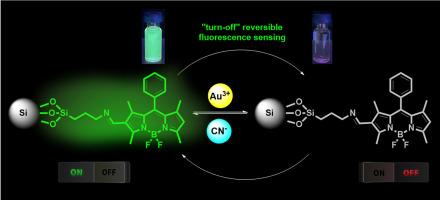可逆荧光传感:BODIPY集成二氧化硅纳米颗粒的敏感和选择性的“关闭”检测Au (III)离子在全水介质
IF 5.2
2区 化学
Q2 CHEMISTRY, PHYSICAL
引用次数: 0
摘要
金离子种类,包括各种氧化态的Au(I)和Au(III),在化学和生物过程中都表现出非凡的特性。然而,过量的金离子,特别是Au3+,会对生物体造成重大风险。特别是高浓度(约200 μM)的Au3+离子会产生剧毒。鉴于其潜在的危害,迫切需要一种精确、灵敏的方法来检测各种环境中的这些离子。在这项工作中,开发了一种高效的新型BODIPY功能化荧光二氧化硅纳米颗粒探针,用于选择性和灵敏地检测Au3+离子。选择BODIPY支架作为信号报告单元,并以共价连接到二氧化硅纳米颗粒上。该探针BOD-SiNP表现出高灵敏度的可逆“关闭”荧光响应(LOD = 48 nM)。利用密度泛函理论(DFT)计算分析了传感系统的结构。此外,BOD-SiNP还成功地检测了实际水样中的Au3+离子。这是第一个研究探索使用二氧化硅纳米颗粒为基础的系统对Au3+离子进行荧光可逆检测。本文章由计算机程序翻译,如有差异,请以英文原文为准。

Reversible fluorescence sensing: BODIPY integrated silica nanoparticles for the sensitive and selective “turn-off” detection of Au (III) ions in fully aqueous media
Gold ion species, including various oxidation states such as Au(I) and Au(III), exhibit extraordinary properties in both chemical and biological processes. Nevertheless, excessive amounts of gold ions, particularly Au3+, can pose significant risks to living organisms. Especially, high concentrations (around 200 μM) of Au3+ ions can be highly toxic. Given the potential hazards, there is an urgent need for precise and sensitive methods to detect these ions in various environments. In this work, a highly efficient and novel BODIPY functionalised fluorescent silica nanoparticle-based probe has been developed for the selective and sensitive detection of Au3+ ions. A BODIPY scaffold was chosen as a signal reporter unit and covalently attached to silica nanoparticles. The probe, BOD–SiNP, demonstrated a reversible “turn-off” fluorometric response with high sensitivity (LOD = 48 nM). Density Functional Theory (DFT) calculations were used to analyse the structure of the sensing system. Also, BOD–SiNP successfully detected Au3+ ions in real water samples. It is the first study to explore the use of silica nanoparticle-based systems for the fluorometric reversible detection of Au3+ ions.
求助全文
通过发布文献求助,成功后即可免费获取论文全文。
去求助
来源期刊

Journal of Molecular Liquids
化学-物理:原子、分子和化学物理
CiteScore
10.30
自引率
16.70%
发文量
2597
审稿时长
78 days
期刊介绍:
The journal includes papers in the following areas:
– Simple organic liquids and mixtures
– Ionic liquids
– Surfactant solutions (including micelles and vesicles) and liquid interfaces
– Colloidal solutions and nanoparticles
– Thermotropic and lyotropic liquid crystals
– Ferrofluids
– Water, aqueous solutions and other hydrogen-bonded liquids
– Lubricants, polymer solutions and melts
– Molten metals and salts
– Phase transitions and critical phenomena in liquids and confined fluids
– Self assembly in complex liquids.– Biomolecules in solution
The emphasis is on the molecular (or microscopic) understanding of particular liquids or liquid systems, especially concerning structure, dynamics and intermolecular forces. The experimental techniques used may include:
– Conventional spectroscopy (mid-IR and far-IR, Raman, NMR, etc.)
– Non-linear optics and time resolved spectroscopy (psec, fsec, asec, ISRS, etc.)
– Light scattering (Rayleigh, Brillouin, PCS, etc.)
– Dielectric relaxation
– X-ray and neutron scattering and diffraction.
Experimental studies, computer simulations (MD or MC) and analytical theory will be considered for publication; papers just reporting experimental results that do not contribute to the understanding of the fundamentals of molecular and ionic liquids will not be accepted. Only papers of a non-routine nature and advancing the field will be considered for publication.
 求助内容:
求助内容: 应助结果提醒方式:
应助结果提醒方式:


